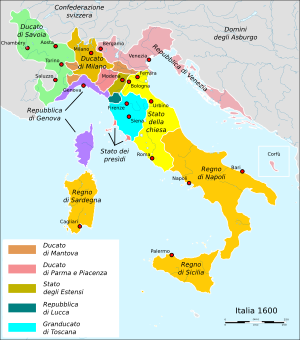War of the Montferrat Succession facts for kids
Quick facts for kids War of the Montferrat Succession |
|||||||||
|---|---|---|---|---|---|---|---|---|---|
 Italy in 1600. Montferrat is portrayed as part of Mantua. |
|||||||||
|
|||||||||
| Belligerents | |||||||||
| Supporting the Duke of Mantua: |
Supporting the Duke of Savoy: |
||||||||
| Commanders and leaders | |||||||||
The War of the Montferrat Succession was a conflict that happened from 1613 to 1617. It was fought over who would rule the Duchy of Montferrat, a small but important area in northwestern Italy. A "war of succession" means a war fought to decide who gets to inherit a throne or territory.
Contents
Why Did the War Start?
The main reason for the war was the death of Duke Francesco IV Gonzaga. He was the ruler of both Montferrat and Mantua. Francesco died in December 1612 without any sons to take his place.
His brother, Ferdinando Gonzaga, was a cardinal (a high-ranking church official). But he decided to give up his church career to become the new Duke of Mantua and Montferrat.
However, Francesco's wife, Margaret of Savoy, was the daughter of Charles Emmanuel I. He was the Duke of Savoy. Charles Emmanuel believed that Montferrat should now belong to his family. He pointed to an old agreement from 1330. This agreement said that if the male rulers of Montferrat died out, the Savoy family would inherit the land.
Who Fought in the War?
Both sides gathered many other states to support them. The war lasted for four years.
- Supporting Ferdinando Gonzaga (Mantua):
* The Spanish Empire * The Kingdom of France (at first, from 1613–14) * The Holy Roman Empire * The Kingdom of Naples * The Republic of Genoa * The Grand Duchy of Tuscany (in 1613)
- Supporting Charles Emmanuel I (Savoy):
* The Duchy of Savoy * The Kingdom of France (later, from 1615–17) * The Republic of Venice * The Grand Duchy of Tuscany (in 1613)
How Did the War End?
The war continued for a long time. In 1615, a peace agreement called the Peace of Asti was discussed. It said that Savoy should give up its claims to Montferrat. However, this agreement was not officially signed at first, so the fighting continued.
Finally, in 1617, Savoy and Spain officially signed the Peace of Asti. This treaty confirmed that Ferdinando Gonzaga was the rightful ruler of Montferrat.
What Happened Next?
Ferdinando died in 1626. His brother, Vincenzo II, became the new Duke of Mantua and Montferrat. Vincenzo had also been a cardinal but left the church.
Sadly, Vincenzo also died in December 1627 without any children who could inherit his titles. This led to another big problem over who would rule Mantua and Montferrat. This new conflict became known as the War of the Mantuan Succession (1627–1632).
Battles
- Siege of Alba (April 22, 1613)
- Siege of Trin (April 26, 1613)
- Siege of Moncalve (April 23 – May 8, 1613)
- Siege of Nizza Monferrato (May 14 – May 23, 1613)
See also
 In Spanish: Guerra de sucesión de Montferrato para niños
In Spanish: Guerra de sucesión de Montferrato para niños

